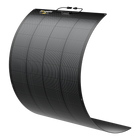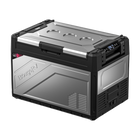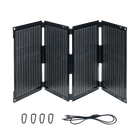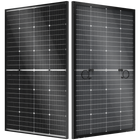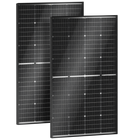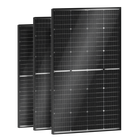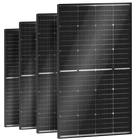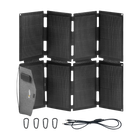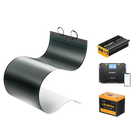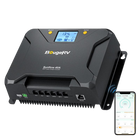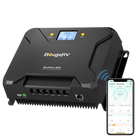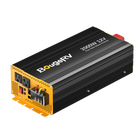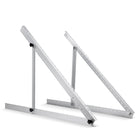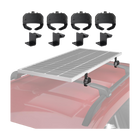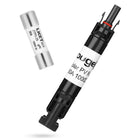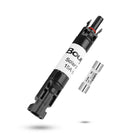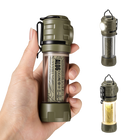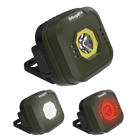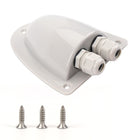Volts To Watts Conversion


Have you ever wondered about the relationship between volts and watts? You're not alone in seeking clarity when understanding the conversion from volts to watts. So, how do volts translate into watts? In short, watts measure power, while volts represent the electrical potential difference. The formula governs the relationship between volts and watts: Watts = Volts x Amperes. In essence, watts describe how much energy is used or produced, and volts indicate the force driving the current. This simple equation forms the core of the volts-to-watts conversion.
However, we are here to shed more light on this topic and give you the confidence to navigate it. Explore practical examples, exceptions, and practical applications to empower you with a comprehensive understanding.
What Is Volt?

A volt is a unit that quantifies the electric potential difference between two points in an electrical circuit. Think of it as the force that drives electrons to move, forming a flow of electricity. Named after Alessandro Volta, the Italian physicist who pioneered the study of electricity in the late 18th century, the volt traces its origins to a humble stack of zinc and copper discs known as the voltaic pile. This early innovation laid the groundwork for our understanding of the electric potential.
Picture a stream finding its way down a mountainside – electrons follow a similar path from areas of higher electric potential to lower ones. The volt measures this journey's intensity; the push electrons need to traverse the circuit. The electrifying difference makes your lightbulb shine, your smartphone charge, your portable power stations deliver, and your world connect.
What Is Watt?

The Watt, named after James Watt, the Scottish inventor whose steam engine revolutionized the industry, measures the rate at which energy is transferred or used. It's the fiery tempo at which electrons dance through circuits, igniting our appliances, gadgets, and innovations.
Imagine the Watt as a storyteller, narrating the tale of energy consumption. It's the reason your coffee machine sputters to life in the morning and the glow that emanates from your TV screen during movie nights. The poetic synergy between voltage and current gives birth to a spectacle of light, sound, and motion.
How Many Volts Are In A Watt?
Volts and watts aren't directly convertible, like apples into oranges. Instead, they're collaborators in the grand performance of electricity.
Volts represent the potential difference that propels electrons, while watts quantify the rate of energy transfer. We need a third element to bridge this gap: current, measured in amperes. The relationship is encapsulated in the formula: Watts (W) = Volts (V) × Current (A). This formula reveals that watts are the product of volts and currents.
So, the number of volts in a watt relies on the current flowing through the circuit. A watt is equal to a volt (V) multiplied by an ampere. See it as a triumvirate of forces working together to create the energy that drives our devices and systems.
Why, Then, Do Electrical Ratings Matter in Solar Power?

In this generation of solar power, where rays of sunlight transform into tangible energy, electrical ratings emerge as the architects of reliability and performance. The question lingers: Why do these ratings matter so profoundly?
Consider solar panels, the gateways to harnessing solar energy. Their electrical ratings determine the power they generate under specific conditions. Wattage ratings unveil their capacity to convert sunlight into usable energy. But this is only one piece of the puzzle.
The inverters, the silent orchestrators of solar systems. Their electrical ratings dictate the efficiency of converting direct current (DC) to alternating current (AC), ready for household use. An ill-matched inverter can rob you of your harvested energy, diminishing your solar aspirations.
Portable power stations and battery storage systems, too, bear electrical ratings that breathe life into your off-grid dreams. Their capacities and discharge rates govern how long they can fuel your gadgets and homes during cloudy spells or nightfall.
How To Convert Volts To Watts?

At the heart of this transformation lies a simple yet mighty formula: Watts (P) = Ampere (I) × Volts (V). This formula encapsulates the dynamic interplay between current and voltage, two fundamental elements of the electrical landscape.
P (Watts) = A (Ampere) × V (Volts)
Where,
P = Power
A = Current in amps
V = Voltage
Alongside, 2 formulas are frequently used to help you convert volts to watts as follows:
Convert DC volts to watts formula: P (in Watts) = V (in Volts) × I (in Ampere). The power of electrical devices is equal to voltage times the current if it is a DC circuit.
Example: If you want to convert 120 volts to watts for a DC circuit having 2 amperes of current.
P = 120 V × 2 A = 240 Watts. So, 120 volts will consume 240 watts of power, given that the amp is 2A.
Convert AC single phase volts to watts: P (in Watts) = PF × I (in Amps) × V (in Volts). The power is equal to PF (power factor) times the RMS voltage times the phase current in the ampere.
Example: If you want to convert 240 volts to watts for an AC electric circuit having 10 amps of current and a power factor of 0.9.
P = 240 V × 10 A × 0.9 = 2,160 watts. So, 240 volts will consume 2,160 watts of power, when the PF is 0.9 and amps are 10.
How To Convert Volts To Watts Using Resistance?
Most times, you know the resistance of the circuit, but the ampere value is not known. In this case, you can use the formula below to convert volts to watts.
Watts = (V)² ÷ Resistance (In ohm)
Consider the scenario: you possess a device delivering 18 volts of electricity and know the circuit's resistance, which stands at 5 ohms. In this case, you can employ a different formula: Watts (P) = (Volts (V)) ² ÷ Resistance (In Ohm). This equation captures the relationship between voltage, resistance, and power.
Let's apply this formula to our example:
Watts = (18 V) ² ÷ 5 Ω = 324 ÷ 5 = 64.8 watts.
Here, the device generates 64.8 watts of energy while overcoming the given resistance. This methodology not only showcases the correlation between volts and watts but also highlights the intricate interplay of resistance in power generation.
Now, the volts are the brushes and watts the strokes on the canvas of innovation. Converting volts to watts unravels the artist's palette, letting you understand the energy spectrum of your appliances and tools.
Best BougeRV Portable Power Stations
In the quest for dependable power on the move, BougeRV's line of portable power stations stands as a beacon of reliability and innovation. Here, we unveil the top contenders in our arsenal, designed to keep your devices humming and your adventures illuminated.
1. FORT 1500 1456Wh LiFePO4 Portable Power Station
Meet the juggernaut: the Fort 1500 portable power station. With an astonishing 1456Wh capacity and a formidable 2200W output, this powerhouse redefines what it means to be self-sufficient. What sets it further apart is the Faster 400W Solar Charging technology, ensuring that your power station gains a significant boost even when the sun shines briefly.
The Fort 1500 is a fortress of safety and reliability featuring high-performance lithium iron phosphate battery cells. It's not just a power station; it's a promise of staying connected and powered in the midst of life's escapades. Wherever your journey takes you, the Fort 1500 stands ready, a loyal companion in exploration.
2. FORT 1000 1120Wh LiFePO4 Portable Power Station
For those seeking a compact yet robust solution, our Fort 1000 enters the scene. Sporting a commendable 1120Wh capacity, this portable power station isn't just a power source; it's a lifeline. With the ability to be charged over 3,500 times, it boasts a lifespan that's twice as generous as its counterparts, making it an investment that keeps on giving.
Whether it's your primary power hub or a reliable backup, the Fort 1000 ensures your devices remain powered in any setting. It's a testament to BougeRV's dedication to quality and longevity, offering peace of mind amidst unpredictable scenarios.
3. NCM 1100Wh Portable Power Station
Compact and versatile, the NCM 1100Wh Portable Power Station redefines convenience. Armed with a robust 1100Wh capacity, it's the ultimate backup power solution for the modern explorer. Charging it is a breeze, whether you're tapping into an AC wall socket or drawing energy from a 12V DC car socket.
Equipped with a scope of DC and AC outlets, the NCM 1100Wh is primed to power an array of devices, from essential electronics to outdoor appliances. As you venture into the wild or embark on weekend getaways, this power station ensures that your experiences are illuminated, and your connection to the modern world remains unwavering.
So, these portable power stations mentioned above aren't just products; they're enablers of exploration, envoys of connectivity, and emblems of innovation. With BougeRV, your power needs aren't just met; they're exceeded, propelling your adventures to new heights of possibility.
Conclusion
As you can see, converting from volts to watts is a pivotal step. This transformation isn't just about numbers; it's about unlocking the potential of energy. Whether you're deciphering formulas, exploring solar dynamics, or delving into power station choices, volts-to-watts conversion is your key to understanding, optimizing, and harnessing the dynamic forces that power our electrified world.
FAQs
1. What Is The Significance Of Volts To Watts Conversion In Electrical Systems?
Volts to watts conversion is crucial as it helps quantify electrical devices' energy consumption and power output. It allows us to understand the relationship between voltage and power, aiding in optimizing energy usage and ensuring efficient operation of various electrical systems.
2. What Role Do Electrical Ratings Play In Choosing A Portable Power Station?
Electrical ratings are vital in selecting a suitable portable power station. These ratings, such as capacity in watt-hours (Wh), output power in watts (W), and charging technology, determine the station's performance and compatibility with your devices. Matching these ratings to your power needs ensures optimal usage.
3. What Is 240 Volts In Watts?
Here’s a useful table converting AC and DC voltages to watts at various currents:
|
Volts (V) |
Amps (A) |
Watts (W) |
|
240V |
1A |
240W |
|
240V |
2A |
480 W |
|
240V |
3A |
720 W |
|
240V |
4A |
960 W |
|
240V |
5A |
1200 W |
|
240V |
6A |
1440 W |
|
240V |
7A |
1680 W |
|
240V |
8A |
1920 W |
|
240V |
9A |
2160 W |
|
240V |
10A |
2400 W |




